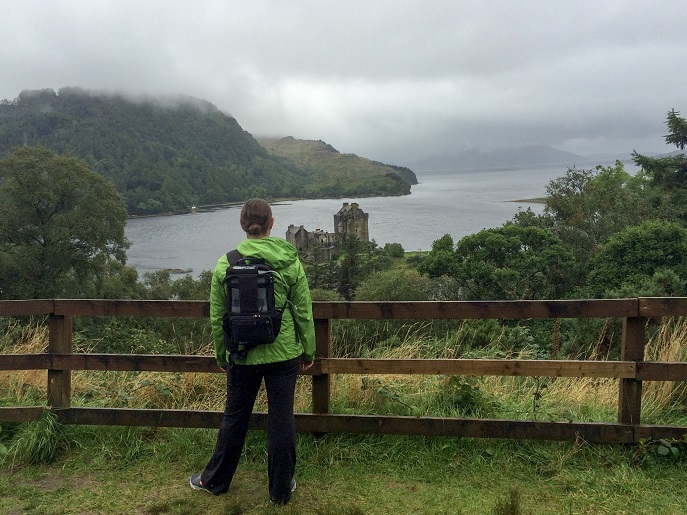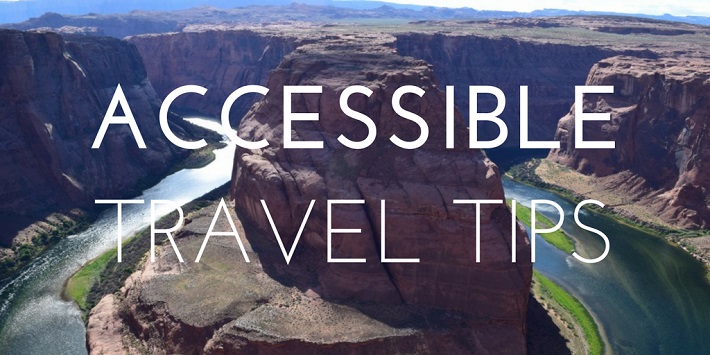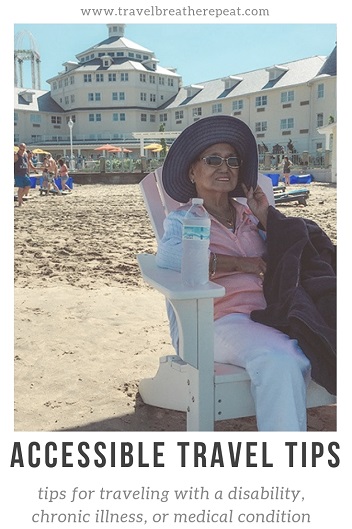Last Updated on 15th November 2018 by Sarah and Justin
Traveling when you’re not perfectly healthy or able-bodied can seem tricky and intimidating. But with some research and advance planning, it can be done. To help you get started, we’re sharing accessible travel tips and practical advice for traveling with a disability, chronic illness, or medical condition.
We think travel is an important part of life and can even be therapeutic. Having something like a disability or medical condition can be isolating, and travel literally brings you out into the world. We know first hand how traveling has helped both of us cope with Sarah having a chronic disease.
We rounded up some helpful accessible travel tips from frequent travelers. A few travel while managing their own medical conditions and others serve as caregivers to help family and friends travel. We’re pleased we’re able to share tips for people with a wide range of conditions and needs from those traveling with insulin to those traveling with food allergies. We hope you find their stories and advice as inspiring and as helpful as we do.
Traveling with insulin

Traveling with insulin should not hold you back. My husband has type 1 diabetes, often referred to as juvenile diabetes, and we have found a few good tricks to traveling by car, RV, or airplane with insulin.
Our family of six travels full-time across the USA in an RV, while my husband takes a few trips each year overseas for work. When road tripping or flying, we have learned a few great tips to managing insulin. First, we purchased a great evaporative medication cooling pack that keeps the temperature regulated for up to two days with the use of only a water-soaked pad. Second, we learned that while in the USA he can transfer his prescription coverage across CVS or Walgreens, as they are pharmacies found nationwide. Last, we have asked his doctor to write the prescriptions for a 3-month supply. This allows us wiggle-room to travel without the worry of running out if we are not near a city with a pharmacy.
While flying, he is sure to have his insulin in his carry-on luggage and has not had any problem getting through security. He does carry a doctor’s note written on a prescription pad explaining that he has type 1 diabetes in case anyone gives him a hard time for carrying his supplies. Do not allow diabetes to hold you back from traveling. It is very doable if you just think through your plan for ways to acquire your insulin and maintain a good temperature so it still functions well.
Jill is currently traveling full-time with her family of six in an RV across the USA while writing and maintaining their family travel blog, Let’s Travel Family. You can also follow her on Facebook.
Traveling with an autistic child

Traveling to Bali with our son has always been a challenge but we look forward to the experiences that we share together as a family. At the age of three, he was diagnosed with Autism Spectrum Disorder (ASD) and Developmental Delay. He constantly runs, stims and struggles to sit still. Bali has given us a place to escape to where we can experience another culture without the usual stares that often happen towards his behaviour in Australia. The Balinese are so lovely and caring, you instantly feel at ease. Our long time Balinese nanny cares for both our kids so well and this allows us to actually really enjoy our holiday.
Travel with an autistic child can be challenging, just like it is at home, but with some forward planning we have actually seen our son flourish and do things that he normally doesn’t do at home when we are on holiday in Bali. Travel doesn’t need to stop with a diagnosis like ASD. The world is a wonderful place to explore and even though some adjustments are needed, exploring is still possible on the spectrum.
Kate lives in Australia with her husband and two kids including their four year old with Autism Spectrum Disorder. They love to travel to Bali and rather than letting the challenges of their son’s diagnosis stop them, they travel there each year enjoying the culture and experiences as a family. Read more of her tips and stories on Rolling Along with Kids and Facebook.
Travel tips for people who are deaf or hard of hearing

My name is Stacey, and I’m Deaf. Because we are living in an audiocentric world, there are challenges. Whether you are Deaf or Hard of Hearing, there are important travel tips.
First, screenshot a lot! If you are traveling and can only use your phone via WiFi, this method is great. Instead of struggling to lip read (in any language), show the images/words. For example, I am allergic to coconut. I’d screen shot an image of coconut and gesture NO to them (such as crossing my arms into an “X” or shaking my head). I also would screenshot different translations, such as in Thai or another language.
Secondly, bring proof of your disabled card. Being Deaf or Hard of Hearing is a hidden disability. Sometimes it can be hard to prove it when some people question you. If you are visiting a theme park where you need to sit in the front row to watch a show up close or see the sign language interpreter, this card may help you.
Lastly, I know that it can be difficult to communicate with others effectively. It is not because of the language barrier, but it is the communication barrier. Use your note app or go old school: pen and paper. It is the most effective way to communicate with others.
Don’t let being Deaf/Hard of Hearing obstruct your ability to enjoy your travel. The problem is not you, it is that the world is audiocentric and should see for who you are, not for what you are.
Stacey is the blogger behind Deafinitely Wanderlust. As a Deaf traveler, Stacey wants to share personal stories and resources for both Deaf and Hearing (referring to those who are not Deaf) communities. You can also follow her on Instagram.
How to develop an emergency plan when you travel

When you’re in great physical or mental distress, it can be difficult to express your needs. This can be a bigger problem when you’re traveling, where the environment, culture and language is different from what you’re used to. If you’re traveling with a companion, it would be good to have an emergency plan in place. Best case scenario – you won’t need it. Worst case scenario – both you and your travel partner know exactly what to do. This helps with both managing and reducing the mistakes made while under great stress.
For me, I always bring along a folder containing important medical documents: a doctor’s letter which summarises all my conditions and medications, my latest blood test results, and my travel insurance policy. During a time of urgency, paper documents are easier to access and quicker to verify, rather than digging through a digital archive. They also don’t run out of battery. Although, it doesn’t hurt to keep a backup in the health app on your phone, which others can access on a locked screen.
I run my travel companion through “the emergency drill” before we set off, so they know where everything is. I also give them instructions for what to do should I suffer a major flare, an epilepsy attack, etc.
Bottom line – have an emergency plan for the worst case scenario. It most likely will not come to that, but it provides everyone with peace of mind.
Sheryl runs A Chronic Voice, a health, wellness and chronic illness blog. She had a mini stroke at 14, followed by multiple blood clots, seizures, heart rhythm dysfunctions and surgeries over the years. She also has a gore-tex band in replacement of a heart valve. She shares her experiences in hope that it raises awareness on silent disabilities, and to let others know they are not alone in this. You can follow her on Twitter.
Traveling with severe food allergies

Traveling in North America with severe shellfish and nut allergies is not that big a deal. That’s assuming that you have the ability to explain your concerns in English, to restaurant wait staff. Of course, you always have your Claritin, Benadryl and Epipen on hand, just in case. But what if you’re in Southeast Asia, the land of Pad Thai and Satay Chicken?
When the chance to travel to Southeast Asia for an extended three month period came along, we needed to find a way to communicate Phil’s food allergies, simply and efficiently. We found the following solution that made both of us confident enough to take the leap and book our flight – we were going! With the help of Google, we managed to translate the following phrase in each country’s language we’d be visiting: “If I eat this food or any food that has been in contact with it or touched it, I will need immediate medical attention and I could die!”
With some visual elements added, we had cards printed and laminated for each country. We used them with great success. We even had English-speaking hotel staff validate the wording before using them with street food vendors. And good thing we did. In Bangkok, we were told that the translation was too formal and that some people might not properly understand them. A simple audio recording to our mobile phone, of the correct message spoken in the local dialect, enabled us to carry on stress-free throughout Thailand. These cards were the perfect solution for us to finally visit Southeast Asia even with severe shellfish and nut allergies.
Phil and Nathalie are a married Canadian couple that quit the 9-to-5 back in 2013. The stories on their travel blog, Marquestra, offer useful information, money-saving tips sprinkled with wanderlust about travel destinations for couples. They’ve managed to visit 50+ countries even though Phil has severe shellfish and nut allergies. You can also follow them on Instagram.
Tips for traveling with celiac disease

We one-percenters (around one in a hundred have coeliac disease) have developed our best hacks to staying well on the road. My first tip is to research your destination; often there’s a resource online to tell you the best safe places to eat when you need to avoid gluten. It also helps to understand something of the local cuisine, and what dishes might be safe. Be aware of the key vocabulary that might be helpful; there are cards available online that spell out a coeliac’s needs in many different languages.
Don’t forget to let your airline know in advance that you’ll need a special meal. I often travel with a backup – airline friendly – picnic just in case. I found a letter from my medic useful to allow me extra food in my bags. Consider booking accommodation where you can do some limited self-catering to balance the need to eat out all the time. Keep your favourite tried and trusted remedies to hand in case you should get accidentally glutened. But most importantly, try to chill into the experience. It can be stressful to have to be constantly vigilant about what you eat. But having safe options planned can ease your mind, and revitalize your travel mojo. Finally, let being coeliac moderate not control your life; there are so many wonderful places to explore, and still so many foodie adventures to be had.
Bernadette is an avid traveler, reader and writer, and has now clocked up more than 50 years on road, rail, sea and air. You can read more of her tips and advice on A Packed Life and follow her on Instagram.
Accessible travel tips for groups

We traveled to Oahu with a friend who was terminally ill and frequently bound to a wheelchair, and our young nephew, who lost a full leg in an on the job accident. The trip was to fulfill a last wish of our friend Sue, who passed four months later from heart failure. Our best advice is to do proper research ahead of time.
It was important for every activity to be an enjoyable experience for everyone. Showing up at an anticipated site, only to find that a member of your party was unable to participate is simply not acceptable. We needed the full accessibility information for each place we planned to visit, AND any other restrictions they may have related to insurance. Believe it or not, there were some places that were fully accessible, but had regulations that prohibited a member of our group from participating due to insurance. We telephoned customer services for full details before our trip so we were certain everyone could participate.
The other critical thing we needed to know ahead of our visit was where to get medical care and equipment if needed. While we all hoped that nothing would go wrong, denying the possibility would have been short-sighted. We found most of the resources we needed through our own research, but we also got recommendations from care personnel at home. As it happened, we had to find a new mouthpiece for a nebulizer, due to one being broken during TSA inspections. Fortunately, we already knew who to call and where to go.
A travel group with different ability levels is a challenge, but by having important information ahead of time, everyone can have a great trip!
Roxanna is an extremely busy senior distribution manager who started Gypsy With a Day Job to inspire and encourage hard woking people to better use their vacation time, to have adventures, and experience ther lives to the fullest. You can also follow her on Facebook.
How to manage dialysis while traveling

Our family travels with my 80 year old grandmother who has end stage kidney failure. This means that her kidneys no longer help with removing wastes from her body. She needs to be on dialysis, which is an artificial way to pull her toxins out of her. We do her dialysis daily at home. The restrictions did not stop us to pack our bags and seek adventures. We just need to be ready for issues that could make her travel less enjoyable.
We always coordinate with her health care team. Is she fit to travel? We let them know where we would be so they know to expect a call from our destination if anything should happen. We bring with us a printout that contains her doctor’s name and contact information, her medical and surgical history, and medication list including generic name, dose, and frequency. This helps an unfamiliar healthcare team to spend less time figuring out who she is and more time to treat her if need be.
It’s important to be familiar with how the disease works. Complications like fatigability, nausea, dizziness, and more are preventable and treatable. Simple yet helpful interventions could include taking breaks in between tours, checking ahead for wheelchair accessibility, verifying if there are health facilities and medications like hers if we needed them, among others. You can read about our Walt Disney World trip and how we arranged for her to do dialysis there.
The best tip we could give to those traveling with unwell companions is to see past the illness. They are the same person you enjoy traveling with who just happened to get sick. Enjoy the moment, indulge in experiences, and make fun memories.
Yamy believes that family is the best travel buddy and loves sharing stories and tips that she learn along the way in her blog Gofamgo and on Facebook. Aside from writing about travel, she is also a registered nurse.
Traveling with a lung disease

Our regular readers know our story. But for anyone new to Travel Breathe Repeat, we wanted to briefly share our experience. Sarah has a rare lung disease called lymphangioleiomyomatosis (LAM). But we haven’t let that stop us from traveling (quite the opposite in fact!). On this blog, you can read about how we’ve become experts at flying with a medical device and the things Sarah should do to keep herself healthy while on the road. Since Sarah’s diagnosis, we’ve traveled the world together and aren’t stopping anytime soon.




This is a great article! Thanks for writing it!
Thank you so, so much for putting together these tips! So helpful to those traveling with any of these conditions.
Awwww this is amazing! Wow it is beautiful to read all these stories! Well done in every single person out there in the world for travelling with certain dificulties. It is hard enough in good health, let alone where you have chronic diseases or bodily disadvantages. Love this so much – thank you for sharing!!
I totally agree in the therapeutic powers of travel. While it certainly takes some preparation, I don’t think anyone should feel like they absolutely can’t travel. One of my favorite things about the National Parks Service is their commitment to making as much of the parks wheelchair accessible as possible. And that emergency action plan is good sense for any traveler.
These are great tips, thank you for sharing. We should all be more aware of those around us that may need assistance. Those of us who are in good health take things for granted and don’t realize the challenges that people with health issues can face. Can’t wait to share this!
Great post! Physical Illness should not restrict our travel mode and of course it is very useful to people who love to travel in the above mentioned scenarios.
I have terrible spinal injuries from car accident and ddd, even though I am in 30’s. I can walk although not far, not steady or fast- for now. I desperately want to take my daughter to Europe. With such a scary health year (cancer scares7+ surgeries), we never truly know how short life is. Thank you for your post. I hope that I can find the stamina to fulfill this dream.
We’re so glad this post resonated with you. Even though traveling with an illness and disabilities can be challenging we truly believe it’s worth it. We hope you fulfill your dream of traveling to Europe! We have a lot of experience traveling there, so if there’s anything we can do to help (questions we can answer, advice we can give), please do let us know!
Pingback: Your Thorough Chronic Illness Travel Guide (with 25 Additional Resources)
Pingback: Top Tips for Travelling with Chronic Illness & Disability (From a Girl Who Loves to Travel) Page